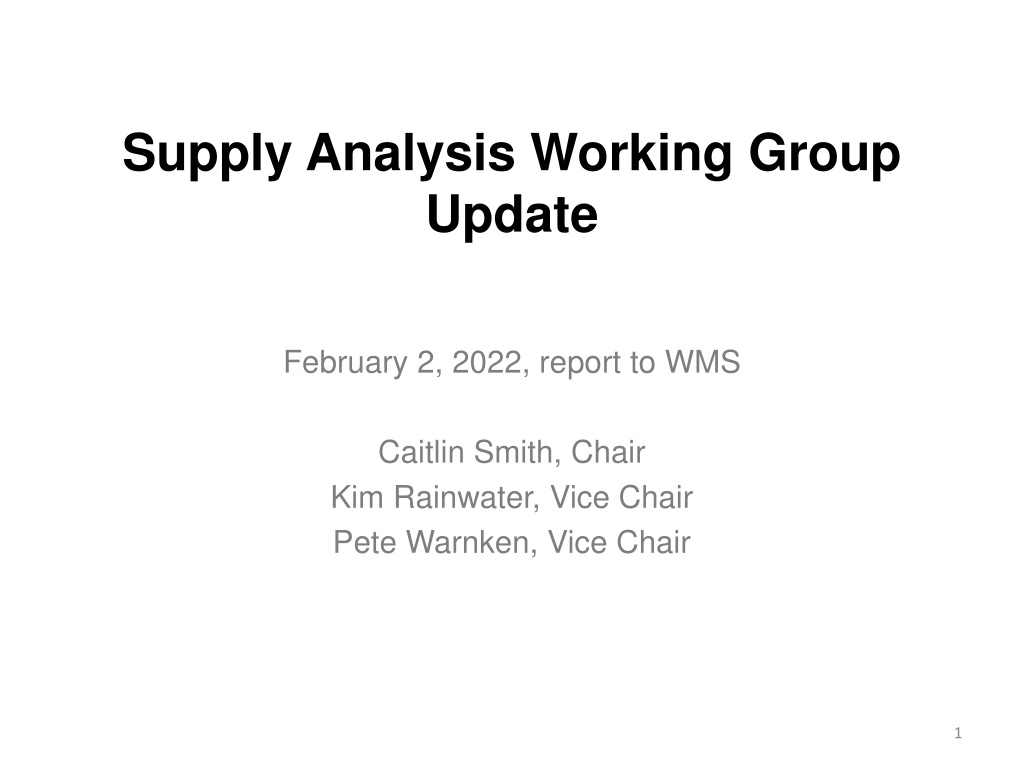ERCOT Supply Analysis Working Group February 2022 Update Report
The Supply Analysis Working Group (SAWG) updated the ERCOT committee in February 2022 on various aspects including long-term load forecast discussions, reductions in load forecasts due to COVID impacts, rooftop PV forecasts, and the December 2021 CDR review highlighting a drop in summer 2022 reserve margin. The discussions included forecasts, adjustments, and ongoing reports to address operational challenges and uncertainties in the ERCOT region.
Download Presentation

Please find below an Image/Link to download the presentation.
The content on the website is provided AS IS for your information and personal use only. It may not be sold, licensed, or shared on other websites without obtaining consent from the author. Download presentation by click this link. If you encounter any issues during the download, it is possible that the publisher has removed the file from their server.
E N D
Presentation Transcript
Supply Analysis Working Group Update February 2, 2022, report to WMS Caitlin Smith, Chair Kim Rainwater, Vice Chair Pete Warnken, Vice Chair 1
Long-Term Load Forecast Discussion January SAWG presentation https://www.ercot.com/calendar/event?id=1638416970696 Load Forecast Report posted January 18 2022 Long-term Load Forecasting page www.ercot.com/gridinfo/load/forecast Update to WMS of January SAWG Meeting 2
Long-Term Load Forecast Discussion Reductions in load forecasts, year over year, attributed to COVID impacts and slower development of West Texas oil & gas load Update to WMS of January SAWG Meeting 3
Long-Term Load Forecast Discussion Rooftop PV Approach First year with hourly rooftop PV forecast was created A forecast was created for residential ESIIDs using the load profile assignment for each weather zone Total installed capacity was approximately 1,030 MW as of September 2021 Forecast is for the total installed capacity to increase to approximately 6,000 MW by August 2031 The gross forecast minus the rooftop PV forecast results in the net forecast Residential ESIIDs with PV have greater average usage per hour than ESIIDs without PV during the early morning and evening hours Some studies suggest that customers with PV tend to use more energy Forecast Adjustments Lubbock added to North Forecast from 2022 on Rayburn added to East Forecast from 2022 on Adjustments added for large industrial facilities (mostly crypto mining) Current assumptions are conservative, due to uncertainty (good topic for future task force) Update to WMS of January SAWG Meeting 4
December 2021 CDR Review Changes from May 2021 CDR: Summer 2022 reserve margin dropped from 28.8% to 23.9%, primarily due to commercial operations delays to planned projects (Supply chain and Federal renewable tax incentive issues account for some of the delays) ERCOT plans to develop new report similar to past interconnection queue analysis that looked at synchronization success rates of planned projects in the queue This will be an ongoing discussion at SAWG on developing the report Update to WMS of January SAWG Meeting 5
December 2021 CDR Review Report design changes: Consolidated all 10 years of forecast data in the Summary tabs, which was the practice prior to the December 2016 CDR Moved the Planned-Resource Scenarios into its own tab to make them more conspicuous; the scenarios reflect resources under various planning criteria Current criteria for inclusion in the CDR Planning Guide Section 6.9(1) requirements Planning Guide Section 6.9 requirements Criteria for inclusion in the Quarterly Stability Assessment Also compares Planning Reserve Margins across the four Planned Resource Scenarios Update to WMS of January SAWG Meeting 6
CDR Modification Roadmap ERCOT discussed preliminary plans to be later reviewed and implemented at SAWG, following internal ERCOT and Public Utility Commissioner input Subject to PUCT approval, CDR improvement initiatives are likely to include: Distributed Generation reporting Replace current Peak Average Capacity Contribution method for IRRs with Effective Load Carrying Capability (ELCC) Including multiple solar regions for ELCC calculation Expand CDR planned resource eligibility criteria Net Peak Load Forecast Methodology Incorporate Reserve Margin Risk Scenarios; possible scenarios include: Different planned resource inclusion criteria Alternate load forecast/demand response assumptions Unconfirmed retirements Capacity Contribution for batteries and thermal DG resources Report Organization & Distribution Update to WMS of January SAWG Meeting 7
Next meeting SAWG next meets March 11, 2022 (note that this was moved from March 9, 2022) Update to WMS of January SAWG Meeting 8























